Overview
- Brief Narrative
- Wooden handled spatula tool used by Aranka Morvay to produce artificial silk flowers from 1941-1942 in Budapest, Hungary, where she had fled with her son Boaz. In 1941, when Boaz was 10, the Axis powers partitioned his country, Yugoslavia. Boaz and his family lived in Zagreb, now part of the Independent State of Croatia, under the Fascist antisemitic Ustasa regime. His father Zvonimir was sent to Jasenovac concentration camp where he perished. Boaz and Aranka escaped to Budapest. In November 1942, they were arrested. Boaz was placed with the Andrash family. Aranka was deported but escaped the transport and returned to Budapest. When German troops occupied the city in March 1943, they went into hiding separately. After six months, they hid together in Budapest until the city was liberated in February 1945. By late spring, they were able to return to Yugoslavia.
- Date
-
use:
1941 June-1942 November
- Geography
-
use:
Budapest (Hungary)
- Credit Line
- United States Holocaust Memorial Museum Collection, Gift of Boàz Givòn
- Contributor
-
Subject:
Aranka Tajtacak
Subject: Boàz Givòn
- Biography
-
Aranka Angela Morvai (Morvay) was born on May 15, 1912, in Zagreb, Croatia, Austro-Hungarian Empire, to a Jewish couple Ignacz and Valerija Schön Morvai. Ignacz was born June 1, 1881 to David Milch and Janka Marmorstein Morvai of Zagreb and was a machine tool company respresentative. Valirija was born March 25, 1888, in Munkacsi Mihaly to Karoly and Ludmila Pfeffermann Schön. Aranka married Zvonimir Veljković, a technician who was born in 1905. With the collapse of the Hapsburg Empire at the end of World War I (1914-1918) the region where Aranka and Zvonimir lived became the Kingdom of Serbs, Croats and Slovenes, known as Yugoslavia. Their only child Boris (Boaz) was born on February 9, 1934, in Zagreb. Ethnic and religious tensions were high in the new country and Croatian fascist groups, such as Ustasa, were fanatically antisemitic and supported the policies of Nazi Germany. That year, with assistance from Ustasa, terrorists killed the King of Yugoslavia. In 1939, his successor agreed to grant Croatia autonomy. During that year, fearing persecution similar to that practiced in Germany, Aranka converted the whole family to the Serbian Orthodox Christian religion.
On April 6, 1941, the Axis powers, Germany, Italy, Hungary, and Bulgaria invaded and partitioned Yugoslavia. Aranka and her family now lived in the Independent State of Croatia, under the Fascist Ustasa regime. A few months later, Boaz’s father Zvonimir was deported to Jasenovac concentration camp. This was the largest of several camps set up by the Ustasa regime to isolate and murder Jews, Serbs, Roma, and other non-Catholic minorities, as well as Croatian political and religious opponents. Around this time, Aranka’s mother fled to Crikvenica on the north cost of the Adriatic Sea.
In summer 1941, Aranka and Boaz escaped to Budapest, Hungary. Hungary was an ally of Germany, joining in the invasion of the Soviet Union launched in June 1941. The government had many restrictive anti-Jewish policies, and Aranka and Boaz lived an unsettled life, changing apartments two to three times a month. Aranka supported them by making artificial flowers, chiefly of silk, and selling them to women’s clothing shops. In November 1942, Aranka and Boaz were arrested as illegal Jewish immigrants by the Hungarian Secret Police. They were tortured, mainly bitten, and after a few days transferred to Rumbach Street synagogue where they were held for several weeks and then separated. Aranka was deported to Auschwitz concentration camp in German occupied Poland. She escaped from the train and made her way back to Budapest. In January 1943, she was admitted to the Budapest Jewish Hospital. Boaz had been placed with the Andrash family, a Hungarian Jewish couple, who cared for him as if he were their own child. He was able to visit Aranka occasionally in the hospital. On July 17, 1943, she entered into a sham marriage with a Hungarian citizen, possibly named Spitzer (Shpitser) and was released from the hospital. In August, she and Boaz were together again. In September, she sent Boaz to a Catholic boarding school in Budapest and they met every other weekend.
In March 1944, German troops occupied Hungary. Aranka and Boaz went into hiding separately. Aranka hid in the city along the Danube River. Boaz was taken to the countryside and placed with a family in Baya, a small town in south Hungary on the shores of the Danube. While there, he attended fifth grade at the town’s Dominican gymnasium. In October, Aranka and Boaz were reunited in the Pest side of Budapest. Aranka pretended that Boaz was her nephew, orphaned after the death of her sister. Aranka was active in a Jewish underground organization, helping to find and distribute food, which was extremely scarce. This organization also provided hidden Jews with false identity papers. They lived in a bunker and the city was under near constant bombardment.
On January 15, 1945, Pest was liberated by the Soviet Army. Aranka and Boaz stayed in the bunker for a few more weeks as fighting continued. The rest of Budapest was liberated on February 13. They left the bunker and returned to their apartment. In March 1945, Yugoslavia opened their consulate in Budapest, and Aranka submitted the forms that would allow them to return home. By the end of March, they were on their way back to Yugoslavia where they settled in Belgrade. It was presumed that Boaz’s father Zvonimir was murdered in Jasenovac in 1942. Aranka, with the surname Spitzer, worked in the National Film Office and Boaz attended 5th and 6th grade. Aranka’s mother had survived the war in Crikvenica and joined them in Belgrade. On April 16, 1946, Aranka (as Angela) married Anđelko A. Tajtacak. Andelko was born on October 12, 1910, in Jagodina in central Serbia, and the family moved there. In October 1947, Aranka and Andelko had a daughter. On November 30, 1948, the family, including Aranka's mother, embarked on the ship Radnik (Workman in Croatian) and sailed from Rijeka to Israel, where they arrived on December 7, 1948. They settled in Nathania. Boaz married Ariela on September 5, 1961. At some point, he took the surname Givon. Aranka, 81, passed away on April 3, 1993, in Israel.
Boris Veljković (later Boaz Givon) was born on February 9, 1934, in Zagreb, Yugoslavia, to Zvonimir and Aranka Angela Morvai Velković. Aranka was born on May 15, 1912, in Zagreb, Croatia, Austro-Hungarian Empire, to a Jewish couple Ignacz and Valerija Schön Morvai. Zvonimir, a technician, was born in 1905. Yugoslavia, or the Kingdom of Serbs, Croats and Slovenes, was created after the collapse of the Hapsburg Empire at the end of World War I (1914-1918.) Ethnic and religious tensions were high in the new country and Croatian fascist groups, such as Ustasa, were fanatically antisemitic and closely aligned with Nazi Germany. In 1934, with assistance from Ustasa, terrorists killed the King of Yugoslavia. In 1939, his successor agreed to grant Croatia autonomy. That year, fearing persecution similar to that practiced in Germany, Aranka converted the whole family to the Serbian Orthodox Christian religion.
On April 6, 1941, the Axis powers, Germany, Italy, Hungary, and Bulgaria invaded and partitioned Yugoslavia. Boaz and his family now lived in the Independent State of Croatia, under the Fascist Ustasa regime. Not long after, Boaz’s father Zvonimir was sent to Jasenovac concentration camp. This was the largest of several camps set up by the Ustasa regime to isolate and murder Jews, Serbs, Roma, and other non-Catholic minorities, as well as Croatian political and religious opponents. Around this time, his maternal grandmother Valerija Morvai fled to Crikvenica on the north cost of the Adriatic Sea.
In summer 1941, Aranka and Boaz escaped to Budapest, Hungary. Hungary was a German ally and joined in the invasion of the Soviet Union launched in June 1941. The government had many restrictive anti-Jewish policies, and Aranka and Boaz lived an unsettled life, changing apartments two to three times a month. Aranka supported them by making artificial flowers, chiefly of silk, and selling them to women’s clothing shops. In November 1942, Aranka and Boaz were arrested by the Hungarian Secret Police as illegal Jewish immigrants. They were tortured, mainly by being bitten, and after a few days transferred to Rumbach Street synagogue where they were held for several weeks and then separated. Aranka was deported to Auschwitz concentration camp. Boaz was placed with the Andrash family, a Hungarian Jewish couple, who cared for him as if he were their own child. Aranka later returned to Budapest, having escaped from the train to Poland. In January 1943, she was admitted to the Budapest Jewish Hospital. Boaz was able to visit Aranka occasionally in the hospital. On July 17, 1943, she entered into a sham marriage with a Hungarian citizen, possibly named Spitzer (Shpitser) and was released from the hospital. In August, she and Boaz were together again. In September, she sent Boaz to a Catholic boarding school in Budapest and they met every other weekend.
In March 1944, German troops occupied Hungary. Aranka and Boaz went into hiding separately. Aranka hid in the city along the Danube River. Boaz was taken to the countryside and placed with a family in Baya, a small town in south Hungary on the shores of the Danube. While there, he attended fifth grade at the town’s Dominican gymnasium. In October, Aranka and Boaz were reunited in the Pest side of Budapest. Aranka pretended that Boaz was her nephew, orphaned after the death of her sister. Aranka was active in a Jewish underground organization, helping to find and distribute food, which was extremely scarce. This organization also provided hidden Jews with false identity papers. They lived in a bunker and the city was under near constant bombardment.
On January 15, 1945, Pest was liberated by the Soviet Army. Aranka and Boaz stayed in the bunker for a few more weeks as fighting continued. The rest of Budapest was liberated on February 13. They left the bunker and returned to their apartment. In March 1945, Yugoslavia opened their consulate in Budapest, and Aranka submitted the forms that would allow them to return home. By the end of March, they were on their way back to Yugoslavia where they settled in Belgrade. It was presumed that Boaz’s father Zvonimir was murdered in Jasenovac in 1942. Aranka, with the surname Spitzer, worked in the National Film Office and Boaz attended 5th and 6th grade. Aranka’s mother had survived the war in Crikvenica and joined them in Belgrade. On April 16, 1946, Aranka (as Angela) married Anđelko A. Tajtacak. Andelko was born on October 12, 1910, in Jagodina in central Serbia, and the family moved there. In October 1947, Aranka and Andelko had a daughter. On November 30, 1948, the family, with Boaz's grandmaother Valerija, embarked on the ship Radnik (Workman in Croatian) and sailed from Rijeka to Israel, where they arrived on December 7, 1948. Boaz married Ariela in Nathania, Israel, on September 5, 1961. At some point, he took the surname Givon. Aranka, 81, passed away on April 3, 1993, in Israel.
Physical Details
- Classification
-
Tools and Equipment
- Category
-
Hand tools
- Object Type
-
Burnishers (tools) (aat)
- Physical Description
- Spatula shaping tool with a turned, brown, spiral grained wooden handle with a loose metal ferrule where the silver colored metal tool, 4.875 in., inserts into the wood. The tool has a short rod that extends and flattens into a thin, curved, spatula with a rounded end. The rounded handle end expands, tapers, and then expands slightly at the top. Three parallel rings are incised near the center. The handle has traces of red stain and the rod has black discoloration, partly from being heated for use.
- Dimensions
- overall: Height: 9.750 inches (24.765 cm) | Width: 1.000 inches (2.54 cm) | Depth: 1.125 inches (2.858 cm)
- Materials
- overall : metal, wood, stain
Rights & Restrictions
- Conditions on Access
- No restrictions on access
- Conditions on Use
- No restrictions on use
Keywords & Subjects
Administrative Notes
- Legal Status
- Permanent Collection
- Provenance
- The flower making tool was donated to the United States Holocaust Memorial Museum in 2003 by Boàz Givòn, the son of Aranka Morvay Tajtacak.
- Funding Note
- The cataloging of this artifact has been supported by a grant from the Conference on Jewish Material Claims Against Germany.
- Record last modified:
- 2022-07-28 18:28:37
- This page:
- https://collections.ushmm.org/search/catalog/irn514818
Download & Licensing
In-Person Research
- By Appointment
- Request 21 Days in Advance of Visit
- Plan a Research Visit
- Request to See This Object
Contact Us
Also in Aranka Morvay Tajtacak family collection
The collection consists of nine flower making tools, documents, a pattern book, and photographs relating to the experiences of Aranka Morvay Veljkovic (later Tajtacak), her son Boàz Givòn, and members of their extended family in Yugoslavia during the Holocaust.
Date: 1936-1992
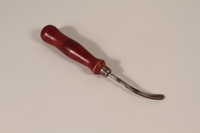
Slotted flower making tool used by a refugee
Object
Slotted curler tool used by Aranka Morvay to produce artificial silk flowers from 1941-1942 in Budapest, Hungary, where she had fled with her son Boaz. In 1941, when Boaz was 10, the Axis powers partitioned his country, Yugoslavia. Boaz and his family lived in Zagreb, now part of the Independent State of Croatia, under the Fascist antisemitic Ustasa regime. His father Zvonimir was sent to Jasenovac concentration camp where he perished. Boaz and Aranka escaped to Budapest. In November 1942, they were arrested. Boaz was placed with the Andrash family. Aranka was deported but escaped the transport and returned to Budapest. When German troops occupied the city in March 1943, they went into hiding separately. After six months, they hid together in Budapest until the city was liberated in February 1945. By late spring, they were able to return to Yugoslavia.
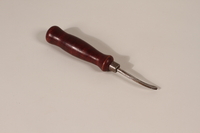
Double slotted flower making tool used by a refugee
Object
Double slotted creasing tool used by Aranka Morvay to produce artificial silk flowers from 1941-1942 in Budapest, Hungary, where she had fled with her son Boaz. In 1941, when Boaz was 10, the Axis powers partitioned his country, Yugoslavia. Boaz and his family lived in Zagreb, now part of the Independent State of Croatia, under the Fascist antisemitic Ustasa regime. His father Zvonimir was sent to Jasenovac concentration camp where he perished. Boaz and Aranka escaped to Budapest. In November 1942, they were arrested. Boaz was placed with the Andrash family. Aranka was deported but escaped the transport and returned to Budapest. When German troops occupied the city in March 1943, they went into hiding separately. After six months, they hid together in Budapest until the city was liberated in February 1945. By late spring, they were able to return to Yugoslavia.
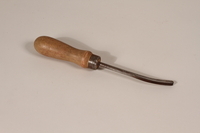
Triple slotted flower making tool used by a refugee
Object
Triple slotted creasing tool used by Aranka Morvay to produce artificial silk flowers from 1941-1942 in Budapest, Hungary, where she had fled with her son Boaz. In 1941, when Boaz was 10, the Axis powers partitioned his country, Yugoslavia. Boaz and his family lived in Zagreb, now part of the Independent State of Croatia, under the Fascist antisemitic Ustasa regime. His father Zvonimir was sent to Jasenovac concentration camp where he perished. Boaz and Aranka escaped to Budapest. In November 1942, they were arrested. Boaz was placed with the Andrash family. Aranka was deported but escaped the transport and returned to Budapest. When German troops occupied the city in March 1943, they went into hiding separately. After six months, they hid together in Budapest until the city was liberated in February 1945. By late spring, they were able to return to Yugoslavia.
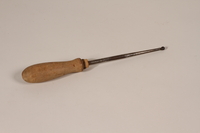
Medium ball tipped flower making tool used by a refugee
Object
Medium ball tipped burnishing tool used by Aranka Morvay to produce artificial silk flowers from 1941-1942 in Budapest, Hungary, where she had fled with her son Boaz. In 1941, when Boaz was 10, the Axis powers partitioned his country, Yugoslavia. Boaz and his family lived in Zagreb, now part of the Independent State of Croatia, under the Fascist antisemitic Ustasa regime. His father Zvonimir was sent to Jasenovac concentration camp where he perished. Boaz and Aranka escaped to Budapest. In November 1942, they were arrested. Boaz was placed with the Andrash family. Aranka was deported but escaped the transport and returned to Budapest. When German troops occupied the city in March 1943, they went into hiding separately. After six months, they hid together in Budapest until the city was liberated in February 1945. By late spring, they were able to return to Yugoslavia.
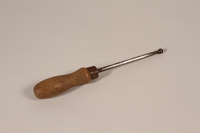
Large ball tipped flower making tool used by a refugee
Object
Large ball tipped burnishing tool used by Aranka Morvay to produce artificial silk flowers from 1941-1942 in Budapest, Hungary, where she had fled with her son Boaz. In 1941, when Boaz was 10, the Axis powers partitioned his country, Yugoslavia. Boaz and his family lived in Zagreb, now part of the Independent State of Croatia, under the Fascist antisemitic Ustasa regime. His father Zvonimir was sent to Jasenovac concentration camp where he perished. Boaz and Aranka escaped to Budapest. In November 1942, they were arrested. Boaz was placed with the Andrash family. Aranka was deported but escaped the transport and returned to Budapest. When German troops occupied the city in March 1943, they went into hiding separately. After six months, they hid together in Budapest until the city was liberated in February 1945. By late spring, they were able to return to Yugoslavia.
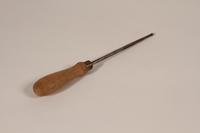
Small ball tipped flower making tool used by a refugee
Object
Small ball tipped burnishing tool used by Aranka Morvay to produce artificial silk flowers from 1941-1942 in Budapest, Hungary, where she had fled with her son Boaz. In 1941, when Boaz was 10, the Axis powers partitioned his country, Yugoslavia. Boaz and his family lived in Zagreb, now part of the Independent State of Croatia, under the Fascist antisemitic Ustasa regime. His father Zvonimir was sent to Jasenovac concentration camp where he perished. Boaz and Aranka escaped to Budapest. In November 1942, they were arrested. Boaz was placed with the Andrash family. Aranka was deported but escaped the transport and returned to Budapest. When German troops occupied the city in March 1943, they went into hiding separately. After six months, they hid together in Budapest until the city was liberated in February 1945. By late spring, they were able to return to Yugoslavia.
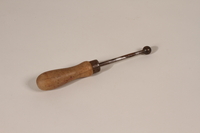
Short large ball tipped flower making tool used by a refugee
Object
Short large ball tipped burnishing tool used by Aranka Morvay to produce artificial silk flowers from 1941-1942 in Budapest, Hungary, where she had fled with her son Boaz. In 1941, when Boaz was 10, the Axis powers partitioned his country, Yugoslavia. Boaz and his family lived in Zagreb, now part of the Independent State of Croatia, under the Fascist antisemitic Ustasa regime. His father Zvonimir was sent to Jasenovac concentration camp where he perished. Boaz and Aranka escaped to Budapest. In November 1942, they were arrested. Boaz was placed with the Andrash family. Aranka was deported but escaped the transport and returned to Budapest. When German troops occupied the city in March 1943, they went into hiding separately. After six months, they hid together in Budapest until the city was liberated in February 1945. By late spring, they were able to return to Yugoslavia.
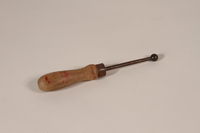
Short medium ball tipped flower making tool used by a refugee
Object
Short medium ball tipped burnishing tool used by Aranka Morvay to produce artificial silk flowers from 1941-1942 in Budapest, Hungary, where she had fled with her son Boaz. In 1941, when Boaz was 10, the Axis powers partitioned his country, Yugoslavia. Boaz and his family lived in Zagreb, now part of the Independent State of Croatia, under the Fascist antisemitic Ustasa regime. His father Zvonimir was sent to Jasenovac concentration camp where he perished. Boaz and Aranka escaped to Budapest. In November 1942, they were arrested. Boaz was placed with the Andrash family. Aranka was deported but escaped the transport and returned to Budapest. When German troops occupied the city in March 1943, they went into hiding separately. After six months, they hid together in Budapest until the city was liberated in February 1945. By late spring, they were able to return to Yugoslavia.
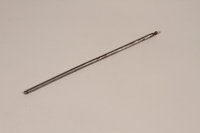
Double end flower making tool used by a refugee
Object
Double end burnishing tool with balled tips used by Aranka Morvay to produce artificial silk flowers from 1941-1942 in Budapest, Hungary, where she had fled with her son Boaz. In 1941, when Boaz was 10, the Axis powers partitioned his country, Yugoslavia. Boaz and his family lived in Zagreb, now part of the Independent State of Croatia, under the Fascist antisemitic Ustasa regime. His father Zvonimir was sent to Jasenovac concentration camp where he perished. Boaz and Aranka escaped to Budapest. In November 1942, they were arrested. Boaz was placed with the Andrash family. Aranka was deported but escaped the transport and returned to Budapest. When German troops occupied the city in March 1943, they went into hiding separately. After six months, they hid together in Budapest until the city was liberated in February 1945. By late spring, they were able to return to Yugoslavia.
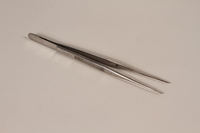
Tweezers used by a refugee to make artificial flowers
Object
Tweezers used by Aranka Morvay to produce artificial silk flowers from 1941-1942 in Budapest, Hungary, where she had fled with her son Boaz. In 1941, when Boaz was 10, the Axis powers partitioned his country, Yugoslavia. Boaz and his family lived in Zagreb, now part of the Independent State of Croatia, under the Fascist antisemitic Ustasa regime. His father Zvonimir was sent to Jasenovac concentration camp where he perished. Boaz and Aranka escaped to Budapest. In November 1942, they were arrested. Boaz was placed with the Andrash family. Aranka was deported but escaped the transport and returned to Budapest. When German troops occupied the city in March 1943, they went into hiding separately. After six months, they hid together in Budapest until the city was liberated in February 1945. By late spring, they were able to return to Yugoslavia.
Aranka, Morvay, and Tajtacak families papers
Document
The papers consist of documents, a pattern book, and photographs relating to the Morvay, Tajtacak and Veljković families during the time period of the Holocaust. The documents include a birth certificate for Aranka Morvay born on May 15, 1912, a marriage certificate dated April 16, 1946, for Andelko Tajtacak and Angela Morvay, and a marriage certificate issued on July 17, 1943, in Pécs, Hungary, to Ignacz Morvay and Valeria Schon. The pattern book belonged to Aranka Morvay Tajtacak and contains sketches of flowers and production notes in Croatian for creating artificial flowers. The group of black and white and color copy photographs (1935-1992) depict members of the Morvay, Veljković, and Tajtacak families.

Oral history interview with Boaz Givon
Oral History



